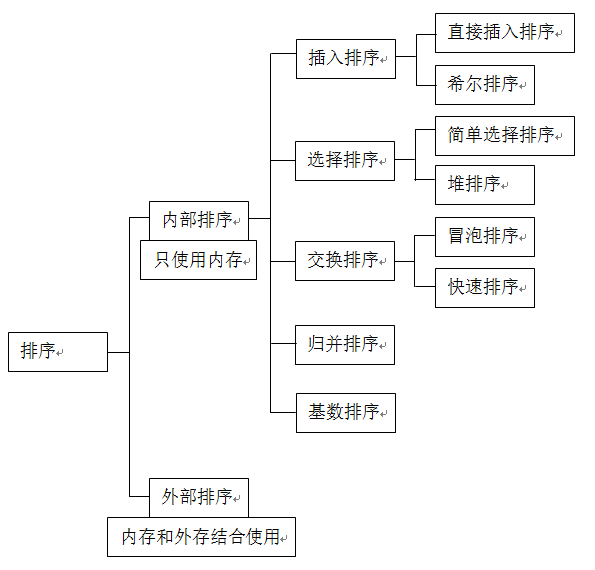C# 笔记——排序
首先,一张图看懂8中排序之间的关系:

平均速度最快:快速排序
所需辅助空间最多:归并排序
所需辅助空间最少:堆排序
不稳定:快速排序,希尔排序,堆排序。
1. 直接插入排序
基本思想:在要排序的一组数中,假设前面(n-1)[n>=2] 个数已经是排好顺序的,现在要把第n个数插到前面的有序数中,使得这n个数也是排好顺序的。如此反复循环,直到全部排好顺序。
for (int i = 1; i < array.Length; i++) { if (array[i] > array[i - 1]) { int tmp = array[i]; int j = 0; for (j = i - 1; j >= 0 && tmp >array[j]; --j) { array[j + 1] = array[j]; } array[j + 1] = tmp; } }
2.希尔排序(最小增量排序)
基本思想:算法先将要排序的一组数按某个增量d(n/2,n为要排序数的个数)分成若干组,每组中记录的下标相差d.对每组中全部元素进行直接插入排序,然后再用一个较小的增量(d/2)对它进行分组,在每组中再进行直接插入排序。当增量减到1时,进行直接插入排序后,排序完成。
int length = array.Length; for (int h = length / 2; h > 0; h = h / 2) { for (int i = h; i < length; i++) { T temp = array[i]; if (temp.CompareTo(array[i -h]) < 0) { for (int j = 0; j < i; j += h) { if (temp.CompareTo(array[j]) < 0) { temp = array[j]; array[j] = array[i]; array[i] = temp; } } } } }
3. 简单选择排序
基本思想:在要排序的一组数中,选出最小的一个数与第一个位置的数交换;然后在剩下的数当中再找最小的与第二个位置的数交换,如此循环到倒数第二个数和最后一个数比较为止。
for (int i = 0; i < data.Length-1; i++) { int min = data[i]; int minIndex = i; for (int j = i+1; j < data.Length; j++) { if (data[j] <min) { min = data[j]; minIndex = j; } } if (minIndex != i) { int temp = data[i]; data[i] = data[minIndex]; data[minIndex] = temp; } }
4. 堆排序
基本思想:堆排序是一种树形选择排序,是对直接选择排序的有效改进。堆的定义如下:具有n个元素的序列(h1,h2,...,hn),当且仅当满足(hi>=h2i,hi>=2i+1)或(hi<=h2i,hi<=2i+1)(i=1,2,...,n/2)时称之为堆。在这里只讨论满足前者条件的堆。由堆的定义可以看出,堆顶元素(即第一个元素)必为最大项(大顶堆)。完全二叉树可以很直观地表示堆的结构。堆顶为根,其它为左子树、右子树。初始时把要排序的数的序列看作是一棵顺序存储的二叉树,调整它们的存储序,使之成为一个堆,这时堆的根节点的数最大。然后将根节点与堆的最后一个节点交换。然后对前面(n-1)个数重新调整使之成为堆。依此类推,直到只有两个节点的堆,并对它们作交换,最后得到有n个节点的有序序列。从算法描述来看,堆排序需要两个过程,一是建立堆,二是堆顶与堆的最后一个元素交换位置。所以堆排序有两个函数组成。一是建堆的渗透函数,二是反复调用渗透函数实现排序的函数。
static void HeapAdjust(List<int> list,int parent,int length) { int temp=list[parent];//parent是索引 int child = 2 * parent + 1; while (child < length) { if (child + 1 < length && list[child] < list[child + 1]) child++; if (temp >= list[child]) break; list[parent] = list[child]; parent = child; child = 2 * parent + 1; } list[parent] = temp; } public static List<int> HeapSort(List<int> list, int top) { List<int> topNode = new List<int>(); for (int i = list.Count / 2 - 1; i >= 0; i--) { HeapAdjust(list, i, list.Count);//最大堆 } for (int i = list.Count - 1; i >= list.Count - top; i--) { int temp = list[0]; list[0] = list[i]; list[i] = temp; topNode.Add(temp); HeapAdjust(list, 0, i); } return topNode; }
5.冒泡排序
基本思想:在要排序的一组数中,对当前还未排好序的范围内的全部数,自上而下对相邻的两个数依次进行比较和调整,让较大的数往下沉,较小的往上冒。即:每当两相邻的数比较后发现它们的排序与排序要求相反时,就将它们互换。
int[] numbers = { 45, 86, 98, 64, 35, 65, 49, 86, 12, 26 }; //定义一个要排序的数组,这里可以随便写多少个数 for (int i = 0; i < numbers.Length - 1; i++) //外层 循环比较遍数 { for (int j = 0; j < numbers.Length - 1 - i; j++) { if (numbers[j] > numbers[j + 1]) //两个数进行比较,如果大于就交换 { int temp = numbers[j]; //temp 两个数交换时要有第三个数来过度 numbers[j] = numbers[j + 1]; numbers[j + 1] = temp; } } }
6.快速排序
基本思想:选择一个基准元素,通常选择第一个元素或者最后一个元素,通过一趟扫描,将待排序列分成两部分,一部分比基准元素小,一部分大于等于基准元素,此时基准元素在其排好序后的正确位置,然后再用同样的方法递归地排序划分的两部分。
private static int QuickSort_Once(int[] _pnArray, int _pnLow, int _pnHigh) { int nPivot = _pnArray[_pnLow]; int i = _pnLow, j = _pnHigh; while (i < j) { while (_pnArray[j] >= nPivot && i<j) j--; _pnArray[i] = _pnArray[j]; while (_pnArray[i] <= nPivot && i<j) i++; _pnArray[j] = _pnArray[i]; } _pnArray[i] = nPivot; return i; } private static void QuickSort(int[] _pnArray, int _pnLow, int _pnHigh) { if (_pnLow >= _pnHigh) return; int _nPivotIndex = QuickSort_Once(_pnArray, _pnLow, _pnHigh); QuickSort(_pnArray, _pnLow, _nPivotIndex-1); QuickSort(_pnArray, _nPivotIndex + 1,_pnHigh); }
7.归并排序
基本思想:归并(Merge)排序法是将两个(或两个以上)有序表合并成一个新的有序表,即把待排序序列分为若干个子序列,每个子序列是有序的。然后再把有序子序列合并为整体有序序列。
//归并排序(目标数组,子表的起始位置,子表的终止位置) private static void MergeSortFunction(int[] array, int first, int last) { try { if (first < last) //子表的长度大于1,则进入下面的递归处理 { int mid = (first + last) / 2; //子表划分的位置 MergeSortFunction(array, first, mid); //对划分出来的左侧子表进行递归划分 MergeSortFunction(array, mid + 1, last); //对划分出来的右侧子表进行递归划分 MergeSortCore(array, first, mid, last); //对左右子表进行有序的整合(归并排序的核心部分) } } catch (Exception ex) { } } //归并排序的核心部分:将两个有序的左右子表(以mid区分),合并成一个有序的表 private static void MergeSortCore(int[] array, int first, int mid, int last) { try { int indexA = first; //左侧子表的起始位置 int indexB = mid + 1; //右侧子表的起始位置 int[] temp = new int[last + 1]; //声明数组(暂存左右子表的所有有序数列):长度等于左右子表的长度之和。 int tempIndex = 0; while (indexA <= mid && indexB <= last) //进行左右子表的遍历,如果其中有一个子表遍历完,则跳出循环 { if (array[indexA] <= array[indexB]) //此时左子表的数 <= 右子表的数 { temp[tempIndex++] = array[indexA++]; //将左子表的数放入暂存数组中,遍历左子表下标++ } else//此时左子表的数 > 右子表的数 { temp[tempIndex++] = array[indexB++]; //将右子表的数放入暂存数组中,遍历右子表下标++ } } //有一侧子表遍历完后,跳出循环,将另外一侧子表剩下的数一次放入暂存数组中(有序) while (indexA <= mid) { temp[tempIndex++] = array[indexA++]; } while (indexB <= last) { temp[tempIndex++] = array[indexB++]; } //将暂存数组中有序的数列写入目标数组的制定位置,使进行归并的数组段有序 tempIndex = 0; for (int i = first; i <= last; i++) { array[i] = temp[tempIndex++]; } } catch (Exception ex) { } }
8.基数排序
基本思想:将所有待比较数值(正整数)统一为同样的数位长度,数位较短的数前面补零。然后,从最低位开始,依次进行一次排序。这样从最低位排序一直到最高位排序完成以后,数列就变成一个有序序列。
public static int[] RadixSort(int[] ArrayToSort, int digit) { //low to high digit for (int k = 1; k <= digit; k++) { //temp array to store the sort result inside digit int[] tmpArray = new int[ArrayToSort.Length]; //temp array for countingsort int[] tmpCountingSortArray = new int[10]{0,0,0,0,0,0,0,0,0,0}; //CountingSort for (int i = 0; i < ArrayToSort.Length; i++) { //split the specified digit from the element int tmpSplitDigit = ArrayToSort[i]/(int)Math.Pow(10,k-1) - (ArrayToSort[i]/(int)Math.Pow(10,k))*10; tmpCountingSortArray[tmpSplitDigit] += 1; } for (int m = 1; m < 10; m++) { tmpCountingSortArray[m] += tmpCountingSortArray[m - 1]; } //output the value to result for (int n = ArrayToSort.Length - 1; n >= 0; n--) { int tmpSplitDigit = ArrayToSort[n] / (int)Math.Pow(10,k - 1) - (ArrayToSort[n]/(int)Math.Pow(10,k)) * 10; tmpArray[tmpCountingSortArray[tmpSplitDigit]-1] = ArrayToSort[n]; tmpCountingSortArray[tmpSplitDigit] -= 1; } //copy the digit-inside sort result to source array for (int p = 0; p < ArrayToSort.Length; p++) { ArrayToSort[p] = tmpArray[p]; } } return ArrayToSort; }


